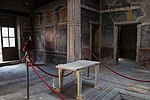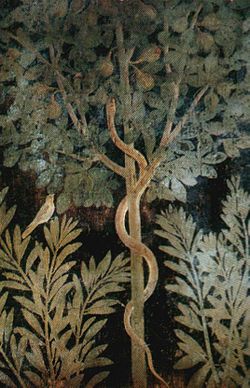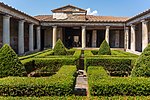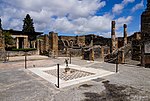House of the Centenary

The House of the Centenary (Italian Casa del Centenario, also known as the House of the Centenarian) was the house of a wealthy resident of Pompeii, preserved by the eruption of Mount Vesuvius in 79 AD. The house was discovered in 1879, and was given its modern name to mark the 18th centenary of the disaster. Built in the mid-2nd century BC, it is among the largest houses in the city, with private baths, a nymphaeum, a fish pond (piscina), and two atria. The Centenary underwent a remodeling around 15 AD, at which time the bath complex and swimming pool were added. In the last years before the eruption, several rooms had been extensively redecorated with a number of paintings.Although the identity of the house's owner eludes certainty, arguments have been made for either Aulus Rustius Verus or Tiberius Claudius Verus, both local politicians.Among the varied paintings preserved in the House of the Centenary is the earliest known depiction of Vesuvius, as well as explicit erotic scenes in a room that may have been designed as a private "sex club".
Excerpt from the Wikipedia article House of the Centenary (License: CC BY-SA 3.0, Authors, Images).House of the Centenary
Viale Giuseppe Mazzini,
Geographical coordinates (GPS) Address Nearby Places Show on map
Geographical coordinates (GPS)
| Latitude | Longitude |
|---|---|
| N 40.7521 ° | E 14.488 ° |
Address
Scavi archeologici di Pompei
Viale Giuseppe Mazzini
80045
Campania, Italy
Open on Google Maps











